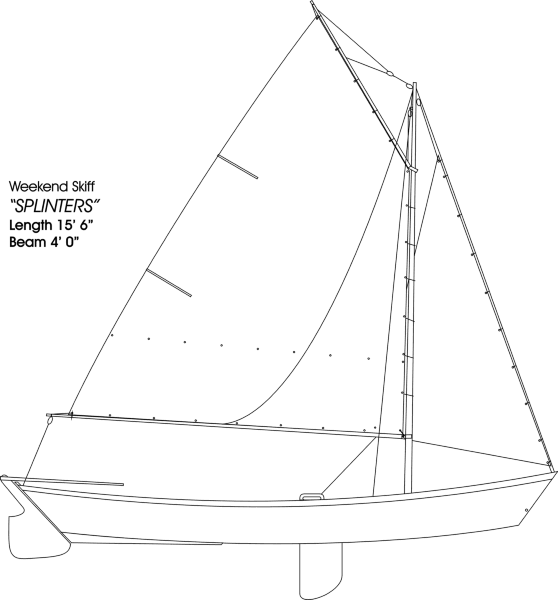When I started planning the project I read all that I could find in my local library about building and rigging sailboats. One of the nicest books I read was Learning to Sail, by H. A. Calahan. It was written in the 1930's and presents the basics of sailing in smaller wooden boats, including the working and rigging of gaff mainsails that were still quite common at the time. Although dated in some areas, such as the use of natural fibers in sails and lines, it still makes an excellent introduction.
That and a handful of other sources inspired me to attempt to rig this little boat as a gaff sloop. The gaff rig is far from common nowadays, being found mostly on vintage and custom wooden boats and a handful of production craft, but it is still a thing of beauty. It is probably the most complex rig I could attempt to put on such a small hull, but not altogether out of place given the boat's "salty" look.
The following is a rough sketch of the final sail plan. It's not exactly to scale and the lines of the hull and position of the centerboard are only approximate.

|
Length: 15½ feet overall |
A lot of folks have built these boats for sailing. Balanced lug and sprit rigs are both known to work quite well. A few have specifically mentioned their attempts to use a full gaff rig on the Skiff and concluded that it wasn't worth the effort. The following remark from the Herkimer & Perkins site is typical:
"My first choice was a gaff main with jib (which proved to be a disaster because my wife and I found on the shakedown cruise that we were sitting on all the strings that I had set up for this ambitious rig.)"
But, then again, all you need to do is look at boats like the Herreshoff 12 1/2 to figure that it can be done. Of course, the Weekend Skiff is not the Herreshoff! It's a flat-bottomed, dagger board boat with a foot less beam and no ballast. It's not obvious that she can safely carry 100 sq. ft. of sail, compared to the 140 sq. ft. of the much stiffer 12 1/2. But at least it seems likely that we can manage the rigging.
This all suggests that I have to work hard to keep things as simple and neat as possible, in order to make a workable boat. My aim is to end up with sufficient sail area and control complexity to promise enjoyment and challenge when the girls have more experience, yet enough ways to trim performance to keep it manageable in fresher air and while we're starting out.
I'll have more to say about the details of the rigging in the Construction pages, including sketches of the masthead arrangement, halyard pinrail, shroud and headstay attachments, sheets, and so on.
Meanwhile, let's look at what we've learned from the performance of the finished boat, in Results.
| Home |